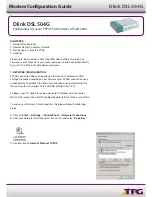
17
3. Operation
3.1 Answering Inbound Calls
The Modem Router Switch answers calls via the following two steps:
1) When a ring signal is received, the switch answers the call, verifies security,
and determines which port is requested.
2) Next, the switch rings the selected port and sends a false ring back to the
caller. When the selected device answers, the call connects.
NOTE
The call will always be answered by the switch, even if the equipment on
the ports will not answer.
If the ports don’t answer, the call may disconnect after three rings. You may also
request a port that is busy on another line. This lets you know that the modem you
requested is not available. In this case, you will hear four busy signals and the
Modem Router Switch will disconnect.
3.2 Optional AC Power Control Unit
The device on the “selected port” does not need to be constantly powered on.
Install an optional AC power strip (part number 40420) at the terminal/modem.
The caller then controls the AC power strip that’s connected to the selected port
through ON/OFF/RESET touch-tone commands.
NOTE
Only the AC outlets on the power strip labeled “Control Ports” are
controlled by the Modem Router Switch. Use the other ports as standard
power-strip ports.
3.3 Programming
3.3.1 P
ROGRAMMING THE
M
ODEM
R
OUTER
S
WITCH
Now that you have an understanding of the components and their functions, you
can program the unit. For example, to program the unit to recognize Touch-tone
input, simply turn the Program Mode Switch to position #2 and press the Enter key
until the Routing LED (#9) turns red. Then, turn the Program Mode Switch to
position #0. The Mode LED turns green to indicate the Run Mode.
CHAPTER 3: Operation
Summary of Contents for 40418
Page 3: ......






































